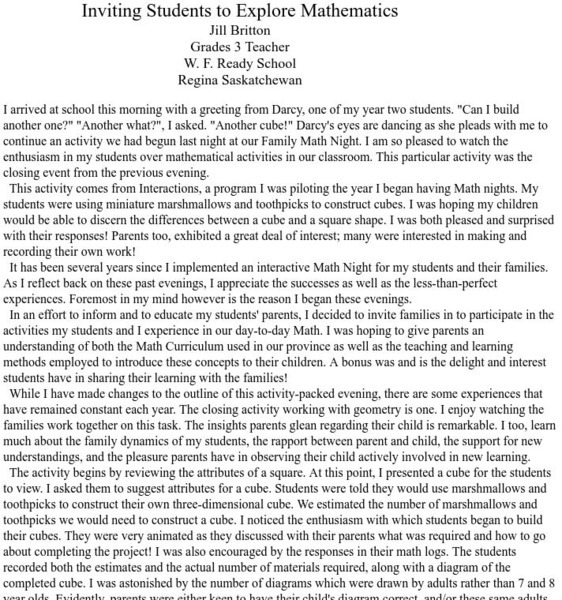Hi, what do you want to do?
Curated OER
Richard's Dice
Students problem solve logic problems. They complete a worksheet using dice as a manipulative. They decide on a problem solving strategy, solve the problem, and write up the solution.
Curated OER
Estimating the Live Mass of Dinosaurs
Students calculate the volume of scale model dinosaurs using a water displacement method. They use formulas to calculate the live mass each of the species of dinosaur. Then they complete and discuss a series of questions.
Curated OER
Estimating the Live Mass of Dinosaurs
High schoolers estimate the live mass of dinosaurs. Using dinosaur and modern animal models, students use simple displacement methods to calculate the volume of the models. They calculate the masses of each model. High schoolers...
Curated OER
Counting More or Less
Students practice counting form 0 to 10. They are introduced to the concept of greater than and less than, through the use of pictures. They make flashcards using 3 X 5 cards with stamps or stickers on one side and the corresponding...
Curated OER
Make Words: Humpback Whale
In this language arts and science worksheet, students examine a picture of a humpback whale and read an informative paragraph. Students then make at least 28 words from the letters in "humpback whale."
Curated OER
i-Density Crisis
Eighth graders determine the density using mass and volume. In this science lesson, 8th graders explain why some materials float or sink. They estimate the density of objects based on whether it floats or sinks in a liquid of known...
Curated OER
Attitude and Interest Survey
In this attitude and interest survey, students answer questions about home, school, friends, favorites and miscellaneous. A website reference for additional resources is given.
Curated OER
Insulation and Buoyancy
Learners predict whether their hands be warmer in ice water with or without a blubber mitten. They construct a blubber mitten using plastic, Crisco and compare their results with a control group. They observe how this affects buoyancy too.
Curated OER
Multi-Dimensional Thinking
Young scholars brainstorm new technological devices that apply cutting-edge 3-D computer modeling software to benefit different professions.
Curated OER
Geo Jammin' - Day 2, Lesson 5: Eeny, Meeny, Miney, Mo
Young scholars, in groups, use song lyrics and math to descrie two and three dimensional shapes.
Curated OER
Geo Jammin' - Day 3, Lesson 9: Attribute Attitude
Second graders read poetry and build their vocabulary through use of the puppet Geo George.
Curated OER
Structures
Students choose which building material to use to create their structure and which animal to house. After being read a story, they examine and identify the differnet types of homes mentioned. They take pictures of their structures...
Curated OER
Our Tangible World is Full of Dimensions
Sixth graders explore characteristics of two and three-dimensional figures. They observe the teacher demonstrate the faces, edges, vertices and names of specific figures. In groups, 6th graders examine and describe given figures. ...
Curated OER
Is It Likely or Is It Unlikely?
n a class discussion Students identify events or situations as being likely to occur or unlikely to occur. Then, they work in pairs to generate likely and unlikely statements to share with the class.
Curated OER
Lengths of Ladybugs
Students are read a book about ladybugs. Using the test, they estimate which page shows the longest trip the ladybug made. They assemble their own ladybug book by following directions on a worksheet. They take measurements on each...
Curated OER
Oak Ridges Moraine: Southern Ontario's Sponge
Students examine the characteristics of the Oak Ridge Moraine in Canada. Using a map, the locate the moraine and present and defend a position on how the resources found there should be used. They must use proper geography terminology...
Curated OER
Plain Figures And Measuring Figures
Seventh graders investigate the mathematical concept of a sector. They apply the concept to an example problem and then move into a more complex application. They find the area of the side of a cone. This is done as students calculate...
Curated OER
The Brown Rice Bonus
Students investigate how brown rice can be incorporated into a daily healthy diet. They practice preparing and storing the rice in the most beneficial ways. Also goals are set to increase the consumption of it in the dose of twice a week.
Curated OER
Earthquake Unit
Eighth graders watch the "Earth, the Environment & Beyond" video on earthquakes. Take notes and give an oral summary. They build a working, two dimensional model of a strike-slip, thrust, or normal fault.
Curated OER
Water Cycle
Learners identify and define evaporation, condensation, precipitation and also, how these interact to complete the water cycle. They identify that water moves in a contimuous cycle, which is powered by the sun. Finally, students name...
Curated OER
Forces in Fluids
In this forces in fluids worksheet, learners answer questions as they relate to forces in fluids. Students complete a chart about atmospheric pressure.
Curated OER
Will The Ice Melt and Overflow?
Students observe what happens when ice in a glass of water starts to melt. In this ice lesson plan, students see that the ice does not make the water overflow, it simply occupies the space it did in frozen form.
University of Regina (Canada)
University of Regina: Math Central: Three Dimensional Cube Activity
This is an activity using marshmallows to make three-dimensional cubes. The article was published in the newsletter ?Ideas and Resources for Teachers of Mathematics?.
Other popular searches
- Writing Cubing Activities
- Cubing Activities English
- Cubing Activities as Review
- Cubing Activities in Health




























